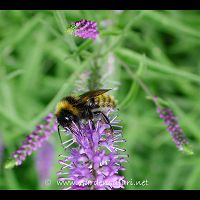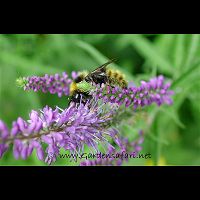Large Yellow Bumblebee Bombus distinguendus
The Large Yellow Bumblebee below shows little black. It does look yellow all over, even though it may appear more brownish at times. Only the centrepart of the thorax has black hairs (or no hairs at all). This is a very variable species in size. Some workers will only reach a length of some 11 mm, especially the very first ones. But the queens may reach a length of 22 mm. Their wingspan can then reach some 42 mm making them almost as big as the Earth Bumblebee. The Large Yellow Bumblebee builds its nest underground (in old micenests preferably) or above the ground in beautifully selfmade nests in shrubs or trees. The species starts flying late in the season and is rarely seen before mid-May. Chances of meeting this remarkable species in your garden are extremely small, for this species is known to be extremely rare in Britain, Holland, Belgium and Germany. So having it flying about in our garden was an enormous thrill indeed! It is known being one of the most beautiful bumblebees around. This species is also known as Megabombus distinguendus.
There is much ado about the identification of the species shown in the pictures on this page. Some claim it is not a Large Yellow Bumblebee, but the male of the Field Cuckoo Bee. Others confirm this is a Large Yellow Bumblebee. According to the German book 'Bumblebees' by Eberhard von Hagen and Ambros Aichhorn the Field Cuckoo Bee is not unlike the Large Yellow Bumblebee, but it only has the last tergites yellow, whereas the Large Yellow Cuckoo Bee has all tergites yellow. So far three experts claim this is a Field Cuckoo Bee and three others claim this is the Large Yellow Bumblebee. One of the last mentioned experts is a pupil of Aichhorn's. Because of this we still feel safe enough to put this animal here being a Large Yellow Bumblebee, but keep in mind it might be another species.
The Large Yellow Bumblebee below shows little black. It does look yellow all over, even though it may appear more brownish at times. Only the centrepart of the thorax has black hairs (or no hairs at all). This is a very variable species in size. Some workers will only reach a length of some 11 mm, especially the very first ones. But the queens may reach a length of 22 mm. Their wingspan can then reach some 42 mm making them almost as big as the Earth Bumblebee. The Large Yellow Bumblebee builds its nest underground (in old micenests preferably) or above the ground in beautifully selfmade nests in shrubs or trees. The species starts flying late in the season and is rarely seen before mid-May. Chances of meeting this remarkable species in your garden are extremely small, for this species is known to be extremely rare in Britain, Holland, Belgium and Germany. So having it flying about in our garden was an enormous thrill indeed! It is known being one of the most beautiful bumblebees around. This species is also known as Megabombus distinguendus.
There is much ado about the identification of the species shown in the pictures on this page. Some claim it is not a Large Yellow Bumblebee, but the male of the Field Cuckoo Bee. Others confirm this is a Large Yellow Bumblebee. According to the German book 'Bumblebees' by Eberhard von Hagen and Ambros Aichhorn the Field Cuckoo Bee is not unlike the Large Yellow Bumblebee, but it only has the last tergites yellow, whereas the Large Yellow Cuckoo Bee has all tergites yellow. So far three experts claim this is a Field Cuckoo Bee and three others claim this is the Large Yellow Bumblebee. One of the last mentioned experts is a pupil of Aichhorn's. Because of this we still feel safe enough to put this animal here being a Large Yellow Bumblebee, but keep in mind it might be another species.





